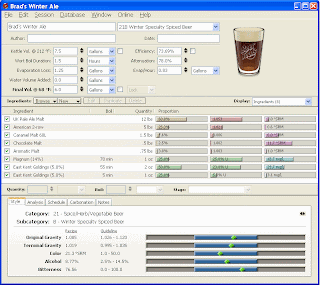
I have only read one good review of this beer, and several ambivalent reviews. I think it would be properly classified as an Amber Ale. I have 2 favorites in this category: Deschutes Green Lakes Amber Ale, and Firestone Double Barrel Ale, and this beer is nothing like them.
Tasting: Chilled to ~40 degrees (f) from a pint glass.
Appearance: 3/3 Beautiful copper color, nice off-white head, champagne-like bubbles.
Head: 3/3 Light, thick head that lasts.
Aroma: 2/3 Very light hops, and maybe some malt?? .
Flavor: 2/3 Very dry, somewhat watery, some yeast bitterness, and light hops, no malt.
Mouth feel: 1/3 Very light body, somewhat overly carbonated.
Overall: 1.5/3 Not very ale-like, very light in flavor, aroma, and bitterness, a few weird flavors that are very subtle, but definately there.
Buzz: 0/3 No buzz after 22 oz.
This is not a bad beer, but it isn't a good beer either. It is the best Budweiser I have had, but not as good as some of the Michelob beers like Amber Bock. A bit more gravity wouldn't hurt, but this is a very drinkable beer.
After purchasing this beer, but before posting this review, I read a couple interesting posts on Beervana discussing whether or not this should be considered a "craft beer". As you can see in my comments, I do not, for the following reasons, repeated here:
Craft brewers and craft beer generally avoid the use of adjuncts unless it is used traditionally, like adding Belgian sugar to a Trippel, and don't use ingredients that the style doesn't call for to change the appearance or flavor or the beer.
After tasting Budweiser American Ale (as an example) 3 things made me suspicious::
1. The head retention was much better than I have ever seen on a light-bodied ale.
2. The body was much lighter than the color would normally permit
3. There were some very subtle off-flavors that I haven't noticed in an ale before.
These could all be in my head, but the above, combined with the fact that the label does not claim "using ONLY the finest malts, hops and water" or something equivelent tells me that the beer has been engineered with adjuncts and ingredients to position it where Budweiser thinks it will be best received by macro-beer drinkers.
If any of the above are true, this is NOT a craft beer in my opinion. It doesn't mean it isn't good beer, but the whole point of craft beer to me is to work to get basic ingredients to do what you want in the beer, accepting that there are tradeoffs, and trying to achieve the best balance with what you have. I think adding chemicals to aid with head retention, or rice to thin an ale changes it into something else, and would be analagous to using acrylic paint to touch up an oil painting. It may look great, but it is no longer an oil painting.
After tasting Budweiser American Ale (as an example) 3 things made me suspicious::
1. The head retention was much better than I have ever seen on a light-bodied ale.
2. The body was much lighter than the color would normally permit
3. There were some very subtle off-flavors that I haven't noticed in an ale before.
These could all be in my head, but the above, combined with the fact that the label does not claim "using ONLY the finest malts, hops and water" or something equivelent tells me that the beer has been engineered with adjuncts and ingredients to position it where Budweiser thinks it will be best received by macro-beer drinkers.
If any of the above are true, this is NOT a craft beer in my opinion. It doesn't mean it isn't good beer, but the whole point of craft beer to me is to work to get basic ingredients to do what you want in the beer, accepting that there are tradeoffs, and trying to achieve the best balance with what you have. I think adding chemicals to aid with head retention, or rice to thin an ale changes it into something else, and would be analagous to using acrylic paint to touch up an oil painting. It may look great, but it is no longer an oil painting.





